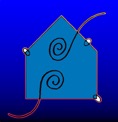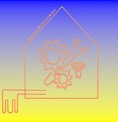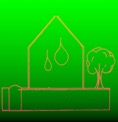How Does It Work
Combining the passive house requirements
with knowledge and experience in the warm climate of Andalusia.
How do we build a passive or zero energy house for you?
First of all there are the wishes and design ideas of the customer himself. Then we take into account the requirements for the official "Passive House Standard“ which has been created by the Passivhaus Institut in Germany more than 25 years ago. Meanwhile this standard has become very successful throughout the world, being used for all kinds of buildings in different climate zones. Combining these requirements with our experience here in Andalusia and our own visions and ideas concerning how to build a high quality and sustainable building we will investigate the possibilities of each project based on the following 6 principles:
The Six Principles
-
The DesignA building needs style and character and on top a well-thought intelligent concept. In order to achieve the standard of a passive house you would need to start from the first scratch: taking into account the orientation towards south, the proportions, the division of the different surfaces, the quantity and the position of windows as well as the shadow from the building itself and its surrounding. All these conditions and factors have a great influence on the future temperature behaviour of the house.

-
Thermal Insulation without Thermal BridgesA sufficient efficient insulation is key for a passive house concept to protect the house against different weather scenarios:

- against the cold in winter
- against cooling through rain or wind
- against the heat in summer
How thick the insulation has to be depends entirely on the climatic conditions and the overall concept and must therefore be calculated on an individual project basis.
A design with a minimum of thermal bridges is absolutely necessary, since these can lead to unexpected internal temperatures and condensation. Thermal bridges can also cause long-term damage to the structure or even mold growth, incl. health problems. Detailing specific structural problem areas is essential to avoid thermal bridges from the outset.
The thermal insulation measures achieve a multi-day buffer effect, which allows the house to continually remain within a pleasant temperature range. Cold walls, ceilings and floors during winter are thereby eliminated. And during summer, the coolness inside the house remains stable for days and weeks at a time. -
Ventilation SystemThe installation of a central ventilation system with heat recovery is necessary to ensure good air quality in a Low-Energy or Passive House.

The ventilation system ensures that:
- the entire building is supplied with high-quality, oxygen-rich air.
- the correct humidity level is maintained and mold growth is prevented.
- allergenic pollen is kept out of the house’s interior as much as possible.
- additional heating or cooling losses encountered with manual window ventilation during the day are avoided (given heat recovery in the ventilation system) -
AirtightnessIn order for the ventilation system to work well, the house must be made airtight, i.e., without hidden, unwanted ventilation zones between the inside and outside.

The airtightness of a house is extremely important because it prevents unpleasant drafts, ensures the functioning of the ventilation system and significantly increases the comfort level within the house.
Airtightness also prevents additional general heating and cooling losses as well as mold growth in places with hidden drafts. At the same time, the balancing buffer effect of a Passive House is made possible. -
Building Technology: efficient and renewableThe scope of the building technology employed in the house can vary greatly and depends primarily on the local situation and the individual project.

The objective is to use intelligent technology:
- to efficiently provide heating, hot water, electricity and water
- with the aid of various locally available natural energy sources such as solar, wind and geothermal.
Rainwater can be collected over a large area and can be used for garden irrigation as well as toilet flushing.
Besides architectural solutions for shading of the building during summer, building technology can help protect the house from overheating by means of automatic and daylight-dependend blind control.
Brine loops in the ground can slightly pre-heat air flowing into the ventilation system during summer and slightly pre-cool it during winter.
With solar thermal modules, the majority of the annual demand for hot water and heating can be met cost-effectively and energy-efficiently. These modules heat up a water tank in the boiler room throughout the year, from which hot water is supplied to the household, including to the heating system.
As an energy-efficient backup heating system for heating on cloudy days, the installation of an air heat pump may be suitable, which can make residual heat available for the tank.
By implementing a customized energy-saving concept, a large part of the electricity demand can be reduced: This includes the use of energy-saving household appliances, high-efficiency pumps and LED lighting.
With solar panels (photovoltaic), the remaining minimized electricity demand of the building can be met with sunlight, which effectively converts the house to a so-called “Zero-Energy House”. -
Building BalanceWe create buildings in balance with their surrounding:

it is of high importance to take into account sustainable building material and to work within a socially fair work environment.
Creating buildings in our sense mean creating a wonderful and healthy atmosphere for living and working…
If you want the learn more about the Passive House Standard please let us know and get in contact with us. If you want to know how we have executed the standard in our house project Villa Sol y Viento, please have a look on the next page or come to visit us in Mijas.
For more information about planning a Passive House, as well as the Passive House concept in general, please visit also the website of the Passive House Institute: www.passivhaus-institut.de
Open all Close all
